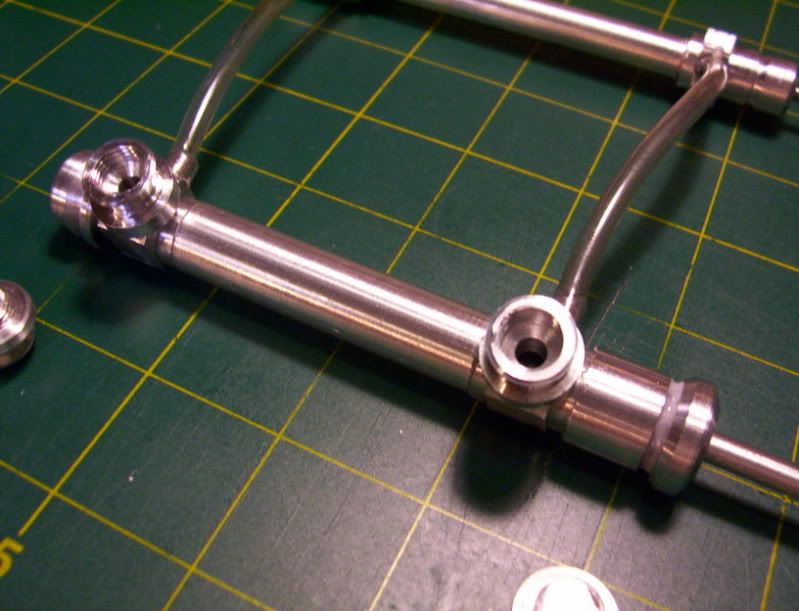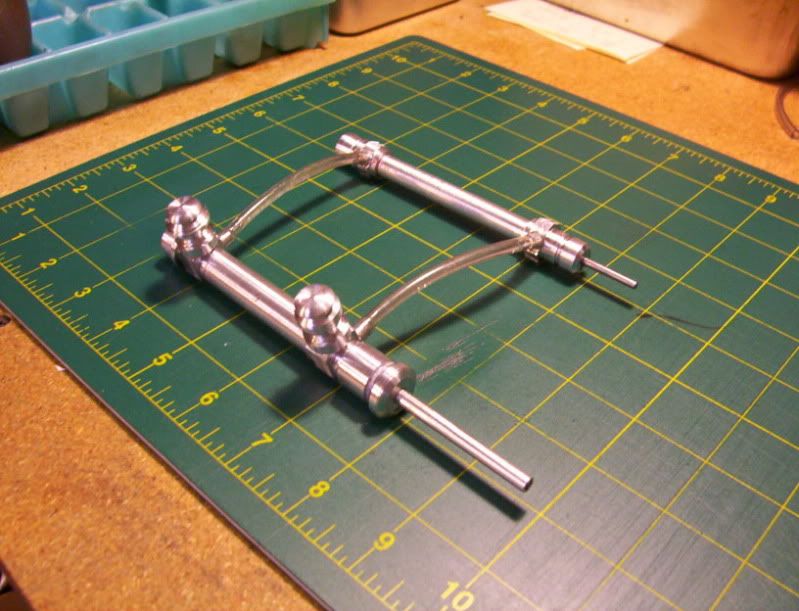- Joined
- Dec 5, 2009
- Messages
- 510
- Reaction score
- 47
OK, the last part of this experimental project.
This is the oil fill reservoirs, for filling the master cylinder, on both sides of the piston.

And the oil caps in place after filling.

Here is a quick working demonstration, using a master-slave system.
http://www.youtube.com/v/m0DMe5CLdwk?fs=1&hl=en_US
This is the last installment for this thread,
I set out to experiment in seeing if it is possible to design and build a double acting hydraulic cylinder, with minimal leaking exspecially where the piston rod exits out the cylinder.
What I've found is that a good seal can be made, making a rubber gasket, to fit tightly around the rod, and containing it using a 2 piece system consisting of a threaded gasket containing ring, and a gasket compression nut, that screws onto the ring with a thru hole to allow passage of the piston rod. Then this assembly screwed onto the top endcap.
Also I learned that making endcaps on both ends of a cylinder, is better, so as to get an accurate reamed thru hole through the cylinder, rather than a cylinder with a blind hole.
A blind hole makes it difficult to get an accurate reaming all the way to the bottom, due to chip build up during the reaming process.
Also making the hose connectors, on the endcaps seem to work real well for a good non leaking fit with the cylinder, as well as a good thread locker and some sort of sealant for all the permanently attached threaded fittings, such as endcaps, and such.
For long length piston rods, I found it's best to make the piston seperate and using drill rod for the piston rod.
As far as making the hose connector (spigot) as one piece with the cylinder or the endcap, is a sure way of keeping out all leaks, however I'm fully convinced with the proper surface area bearing points, that a seperate spigot, can be screwed into the cylinder or endcap, or any other workpiece, provided it is fastened in ,using a threadlocker, and a sealant of some sort.
Or even a gasket of some sort. But threadlocker seems to be the key ingrediant to this 2 piece spigot system.
Thankyou to everyone, who contributed ideas in making this a succesful experiment,
and thankyou to everyone who has been following this thread.
Thankyou, and God Bless...
This is the oil fill reservoirs, for filling the master cylinder, on both sides of the piston.

And the oil caps in place after filling.

Here is a quick working demonstration, using a master-slave system.
http://www.youtube.com/v/m0DMe5CLdwk?fs=1&hl=en_US
This is the last installment for this thread,
I set out to experiment in seeing if it is possible to design and build a double acting hydraulic cylinder, with minimal leaking exspecially where the piston rod exits out the cylinder.
What I've found is that a good seal can be made, making a rubber gasket, to fit tightly around the rod, and containing it using a 2 piece system consisting of a threaded gasket containing ring, and a gasket compression nut, that screws onto the ring with a thru hole to allow passage of the piston rod. Then this assembly screwed onto the top endcap.
Also I learned that making endcaps on both ends of a cylinder, is better, so as to get an accurate reamed thru hole through the cylinder, rather than a cylinder with a blind hole.
A blind hole makes it difficult to get an accurate reaming all the way to the bottom, due to chip build up during the reaming process.
Also making the hose connectors, on the endcaps seem to work real well for a good non leaking fit with the cylinder, as well as a good thread locker and some sort of sealant for all the permanently attached threaded fittings, such as endcaps, and such.
For long length piston rods, I found it's best to make the piston seperate and using drill rod for the piston rod.
As far as making the hose connector (spigot) as one piece with the cylinder or the endcap, is a sure way of keeping out all leaks, however I'm fully convinced with the proper surface area bearing points, that a seperate spigot, can be screwed into the cylinder or endcap, or any other workpiece, provided it is fastened in ,using a threadlocker, and a sealant of some sort.
Or even a gasket of some sort. But threadlocker seems to be the key ingrediant to this 2 piece spigot system.
Thankyou to everyone, who contributed ideas in making this a succesful experiment,
and thankyou to everyone who has been following this thread.
Thankyou, and God Bless...




























![MeshMagic 3D Free 3D Modeling Software [Download]](https://m.media-amazon.com/images/I/B1U+p8ewjGS._SL500_.png)









![DreamPlan Home Design and Landscaping Software Free for Windows [PC Download]](https://m.media-amazon.com/images/I/51kvZH2dVLL._SL500_.jpg)






















